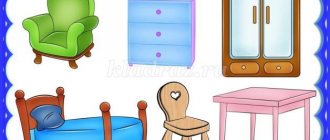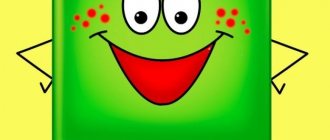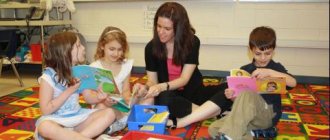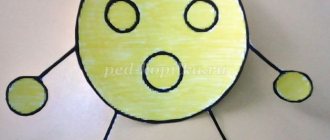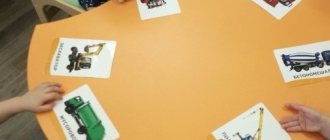MAGAZINE Preschooler.RF
Summary of developmental activities with elements of fairy tale therapy for children of the second junior groupCOMPLETED: Karpova Olga Viktorovna Teacher – psychologist
Explanatory note.
Education plays a leading role in the mental development of a child. Education of children should be imbued with concern for their full development. To do this, it is necessary to know how learning and development relate to each other, to take into account their relationship, carefully selecting the content and methods of teaching a child at different stages of his life. Mental development does not occur on its own, regardless of training. The leading role of training in development was substantiated by the Russian psychologist L. S. Vygotsky. Training, according to him, should take into account the achieved level of development, but not in order to stop there, but in order to understand where development is heading, what the next step should be. Education should always be ahead of mental development and lead it along.
The leading role of learning in mental development is manifested in the fact that a child, mastering new actions, first learns to perform them under the guidance and help of an adult, and then does it independently. According to L.S. Vygotsky, learning is only good when it creates a child’s zone of proximal development. Under such conditions, the child, learning with the help of an adult, successfully begins to do what he previously could not do on his own.
How to organize education for young children? Through a more accessible and pleasant form of communication for them, through play. The study of children's development shows that all mental processes develop more effectively in play than in other types of activities. Play is the activity most mastered by children. In it they draw models for solving new life problems that arise in knowledge and work.
In preschool age, play becomes the leading activity, but not because the modern child, as a rule, spends most of his time
spends in entertaining games - the game causes qualitative changes in the child’s psyche. Gaming activity influences the formation of arbitrariness of mental processes. Thus, in play, the child begins to develop voluntary attention and voluntary memory. When playing, children concentrate better and remember more. The conscious goal stands out to the child earlier and easier in the game. The very conditions of the game require the child to concentrate on the objects included in the game situation, on the content of the actions being played out and the plot. The game situation and actions in it have a constant influence on the development of the mental activity of a preschool child. Gradually, playful actions with objects are reduced, the child learns to think about objects and act with them mentally.
A fairy tale - what is it for a child? A fairy tale is the language of children. A fairy tale tells him about life in an accessible language, teaches him, illuminates the problems of good and evil, and shows him a way out of difficult situations. Fairy tales can easily be called one of the most effective means of raising and teaching a child. As mentioned above, children learn through play, and a fairy tale is the same game, only a game in the imagination. It is much easier to teach a child some skills during play, and it is also much easier to explain something to him using fairy tales. The role of a fairy tale can be considered in a broader aspect - with the help of a fairy tale it is possible to overcome the negative aspects of personality that are just beginning to form, also expand the child’s vocabulary, help learn how to properly build a dialogue with an interlocutor, develop logical coherent speech, among other things, while reading a fairy tale , the baby develops and consolidates the ability to ask questions. In addition to speech, other mental processes of the child can be developed by including fairy tales in activities with children.
Features of mental development of children from three to four years old.
The second youngest group is children from 3 to 4 years old. This age refers to the period designated in Russian psychology as preschool childhood (from 3 to 7 years). This period is preceded by the period of early childhood (from 1 to 3 years). It is necessary to take into account and trace the boundary between early and preschool age when developing a program of developmental work with children, and also not to forget about the individual characteristics of a particular child.
The end of early childhood ends with the three-year crisis. Its essence lies in the fact that the child develops an image of himself. The child moves from calling himself in the third person to calling himself in the first person, while striving to establish himself in different areas. L.S. Vygotsky emphasized both the negative and positive aspects of the crisis. Negative - the child’s negativism, stubbornness, obstinacy, self-will. Positive - separation from an adult, distinguishing oneself as an individual, manifestation of independence. The crisis of three years proceeds primarily as a crisis of social relationships between the child’s personality and the people around him. A child of the fourth year of life can separate the person performing the action from the action itself. Now the child performs the action, imitating the adult. But the child’s capabilities are still limited, and a contradiction arises between the desire to act “like an adult” and reality, which is resolved in the development of role-playing games.
Role-playing play becomes the leading activity in preschool age. The peculiarity of this game activity is that it highlights the role and game actions. A new form of communication with adults is emerging, which is characterized by their cooperation in cognitive activity. The new form of communication is non-situational and cognitive; it is based on the respectful attitude of an adult and his assessment.
Thinking gradually moves from visually effective to visually figurative. This is one of the main neoplasms of preschool age. In early preschool age, the development of perception continues. If by the age of 3 a child can point to 6 primary colors and 5 shapes, then by the age of 4 the child can relatively easily name the shapes and colors of surrounding objects.
With the development of play activities, children's imagination begins to improve. To develop it, you should use a wide variety of situations, for example, showing a toy (or picture), asking “Who is this?” Where did you come from? What did you do before?” .
Attention at this age is involuntary: a child can concentrate on one thing for no more than 10-15 minutes, which must be taken into account when organizing classes.
Child development is closely related to the development of visual arts. A feature of visual activity at this age is that the resulting image controls the design, which follows what the child depicts. Mastering constructive activities is also important for the development of the cognitive sphere. At this age, children can correlate such properties of objects as height, size, length.
In early preschool age, much attention should be paid to the development of children's speech. The sound side of speech is still imperfect. Its grammatical side is also being improved. If up to 2 years old nouns and verbs, after 2 years old adjectives, prepositions, conjunctions, and from 3 to 7 years old declension and conjugation of verbs. Vocabulary of about 1000 words. The question arises - why? The regulatory function of speech is formed, that is, the use of speech to regulate one’s own behavior.
At this age, the child is emotional: proud, touchy, joyful, sad, friendly, hostile, envious, capable of sympathy.
Taking into account the characteristics of this age period, it is important to use games and fairy tales with demonstration, so that there is a process of manipulating and performing actions with objects, toys (closer to 4 years, start working with images and symbols), use different intonations of the voice, play out all the actions, use more games to tactile perception.
Classes with children 3-4 years old should solve the following problems: awareness of emotional manifestations, reduction of impulsivity and development of self-regulation, development of children's play activities, development of observation, auditory and visual perception, development of speech and fine motor skills, development of a friendly attitude towards children. Games with children should be aimed not only at the development of individual mental processes, but aimed at a general, most comprehensive familiarization of the child with the world of objects, people, relationships, during which the gradual improvement and complication of all mental cognitive processes takes place.
We must remember about the problem of children’s adaptation to a child care institution at this age stage. Therefore, it is important to use more games for socialization and relieving psycho-muscular tension, and these are games, rhymes, pestles with stroking yourself, games for expressive movements and showing emotions, relaxation games.
Structure of activities with children.
Start of class.
Classes begin with the same song, which helps to switch attention to the lesson. For example, the song “The giraffe has spots, spots..” or “bus” “Aerobics for Kids” by Sergei and Ekaterina Zheleznov .
Welcome ritual.
Several options for the greeting ritual.
- Let's say "Hello" three times. All children in a circle (can be sitting, can be standing) hold hands. Let's say "Hello" quietly, say "Hello" louder "Hello" even louder .
- Hello, hello sunshine! (with each phrase shown).
We will sow the grain, Soon a sprout will grow, A bridge will be thrown, We will walk along the bridge, We will come to visit the sun.
3. "Bell" . Children take turns ringing the bell to the words of the teacher: “Tanya has a bell, a cheerful bell, dili-dili-don a cheerful bell .
A fairy tale or a game.
Tasks (modeling, appliqué, design), games on the theme of fairy tales, sketches on the ability to express emotions (children with a psychologist show various emotional states
Outdoor game. They are aimed at relieving psychomuscular tension, developing general motor skills, the ability to regulate one’s behavior according to the rules, getting to know one’s body, and learning to control it.
End of class ritual.
The ritual can consist of two parts: a relaxation exercise,
harmonization of the child’s internal state, and an exercise to unite children.
1. Laying down the doll (toy).
Children can sit on chairs, and if the room allows, they can sit or lie down on the carpet. To the music, children rock the toy, and after the end of the song, carefully put the toy back in place.
2. "Rays of Sunshine".
Children stand in a circle, stretch their hands forward and join them in the center of the circle.
Lesson duration is 25-30 minutes.
Options for developmental activities.
Lesson option using a fairy tale
Fairy tale "Puff"
We make a fairy tale for young children shorter than the real version, based on the characteristics of attention at a given age.
Figures of grandfather, grandmother, granddaughter, hedgehog, pictures of cabbage, carrots, turnips, cards of corresponding colors.
Once upon a time there lived a grandfather, grandmother and granddaughter Alyonka. And they had a vegetable garden. Cabbage, carrots, and yellow turnips grew in the garden. (the teacher shows the children pictures of vegetables and puts them in the right order, says to the children that cabbage is green, and puts a card with green under the picture, then the same with carrots and turnips). One day my grandfather wanted to eat turnips. He went out into the garden. He walks and walks, and it’s quiet in the garden, only the bees are buzzing and the mosquitoes are ringing (the children, together with the teacher, voice the bees and mosquitoes).
Grandfather passed a bed with cabbage, passed a bed with carrots. And here the turnip is growing. He just bent down to pull out a turnip, and someone from the garden hissed at him:
- Pssh-pp-y-hh! Pssh-pp-y-hh! (children repeat)
The grandfather got scared and ran away. He runs past a bed of carrots, past a bed of cabbage (pay attention to orientation in space: from left to right and back)… His heels are already sparkling. At home, his grandmother asks him:
- Well, grandfather, did you bring the turnip?
- Oh, grandma, there is such a terrible beast sitting there that I could barely carry my legs away!
- Yes, that’s enough, grandfather! I’ll go myself, I’ll probably bring a turnip...
And the grandmother went to the garden, and it was quiet in the garden, only the bees were buzzing and the mosquitoes were ringing. The grandmother walked and walked past a bed of cabbage, past a bed of carrots.
And here is the turnip. The grandmother bent down to pull out the turnip, and then someone hissed at her:
- Pssh-pp-y-hh! Pssh-pp-y-hh!
The grandmother got scared and ran away. She ran and ran past the carrots, ran past the cabbage. I barely made it home. She sat down on the bench, breathing heavily, couldn’t catch her breath.
- Oh, grandpa, you’re right! Someone is sitting there under a bush, so scary, and puffing. I barely lost my legs!
Granddaughter Alyonka looked at her grandparents, felt sorry for them and said:
- I'll bring a turnip!
Alyonka went to the garden. And in the garden it is quiet, only the bees are buzzing and the mosquitoes are ringing.
She walked and walked past a bed of cabbage, past a bed of carrots. And here is the turnip.
And just as she bent down to pull out the turnip, someone hissed from the garden bed:
- Pssh-pp-y-hh! Pssh-pp-y-hh!
Alyonka laughed and shouted in a ringing voice:
- It's me, Alyonka! Grandma and Grandpa came for a turnip.
And in the garden someone starts puffing again:
Pssh-pp-y-hh! Pssh-pp-y-hh!
Alyonka bent over the garden bed to see who was sitting there so scary, and suddenly she saw: some kind of prickly ball lying on the garden bed, its beady eyes sparkling and puffing:
- Pssh-pp-y-hh!
The girl laughed:
- Oh, you hedgehog, you prickly hedgehog! Did you scare your grandparents? Did you drive them home?
And the hedgehog extended his sharp muzzle upward and again:
- Pssh-pp-y-hh! Pssh-pp-y-hh!
Alyonushka pulled the turnip once, pulled another and a third, and pulled out the turnip. Yes, so big, round and yellow. Alyonka took the turnip, put the hedgehog in her apron, and went home. I ran past the carrots, I ran past the cabbage. And she immediately ran home. And her grandfather and grandmother came out to meet her. And they ask:
- Where is the turnip?
- And here’s a turnip for you!
Grandfather and grandmother were happy here:
- Well, we have a granddaughter! Well, Alyonushka! Well done girl! But what about this beast - the terrible Puff? Aren't you scared of him?
Here Alyonka opened her apron:
- And here’s Pykh!
The old men laughed:
Well done Alyonka! What a brave girl!
Tasks:
- Show the children pictures (or draw) emotions (sorrow-joy), and the children must choose the right picture that matches the end of the fairy tale.
- conduct a conversation on the topic “What grows in the garden?” With display of pictures and color cards. Ask the children to remember what vegetables grew in their grandfather’s garden in a fairy tale
- make hedgehogs out of plasticine (roll into a ball, needles - you can use toothpicks). Or use ready-made drawings to make needles from plasticine.
Offer to feed the hedgehogs. For example, apples. We make apples from plasticine and attach them to the hedgehogs’ backs.
Using the example of such a fairy tale and tasks, we develop speech, perception of color, attention, memory, expand knowledge about the environment (knowledge of vegetables, fruits), learn to distinguish emotions, teach courage, and develop fine motor skills.
Outdoor game. Where do hedgehogs live? In the forest. There are also snakes in the forest. Let's play snake. The snake will catch its tail. Children stand in a line, holding their shoulders. The first child is the head, the last is the tail of the snake. The head should reach and touch the tail. The snake's body is inseparable. Once the head grabs the tail, it becomes the tail and the children switch places.
Lesson option using a poem.
The teacher shows a bunny toy. Who came to visit us. The bunny greets the children, the children touch him, and the teacher asks: “What is he like?” (soft), “What kind of ears does the bunny have?” (long), “What does a bunny like to eat?” (carrots, cabbage) Let's choose from the cards those vegetables that he loves.
The teacher reads a poem:
“The mistress abandoned the bunny, the bunny was left in the rain. I couldn’t get off the bench. I was soaked to the skin.”
(A. Barto)
Tasks for expressive movements: the teacher, together with the children, shows with movements:
like a bunny is sad (lower your head, hunch your back, pressing your “paws” to your body, portray an unhappy expression on your face); like a bunny is cold (shrink your whole body, pretend to tremble); how you can call a bunny with your voice and movement (affectionately say: “come here” , while simultaneously swinging your hand “towards you” ); how you can help the bunny: warm it up (hug it carefully, wrap it in something warm, for example a doll blanket, and also depict how we warm the frozen paws of a bunny with our breath); feed (extend your hand to the bunny with an “open palm” , as if there is something tasty for the bunny in it); take pity (gently stroke his head, paws, back, while looking friendly into his eyes, you can at the same time speak tender words, pronouncing them with soft intonations).
The teacher encourages children to search for different options “solving” the task by asking the question: “How else can you help the bunny?”
Then the teacher suggests breaking into pairs, in each pair deciding who will be the “bunny” and who will feel sorry for him.
Fine motor skills task. Children make fur for a bunny out of cotton wool (tear off small pieces of cotton wool and glue them onto the drawing), on sheets with drawn bunnies (you can make carrots for the bunny).
Design assignment. We make a paper bunny applique from circles.
Outdoor game. Let's play fox and bunnies.
Conclusion
Correctly chosen games help children not only develop their cognitive processes, but also overcome behavioral deviations and prevent the manifestation of unfavorable forms of behavior. Any game, poem, even a seemingly boring task can be turned into a fairy tale, which will interest and captivate children. But there should always be visual positive accompaniment. In the classroom, you need to constantly distinguish the successes and achievements of each child, even the most insignificant ones. All sketches and movements must be performed with children, without making comments. It is better to approach the content of classes creatively, you can add something, change something, and also note the mood of the children, the problems of specific children.
Bibliography
- Alyabyeva E.A. Correctional and developmental classes for children of senior preschool age
- Veraksa N.E. Child development in preschool childhood
- Galanova T.V. Educational games for children under three years old
- Dubrovina I.V. Practical educational psychology
- Panfilova M.A. Communication play therapy
- Khukhlaeva O.V. The path to your Self
| Next > |
Types of fairy tales
Razida Tkach in her book “Fairytale Therapy for Children’s Problems” identifies types of fairy tales from the perspective of individual problems:
- on overcoming fears (the dark, the doctor’s office, etc.)
- to reduce hyperactivity
- to overcome aggressiveness
- aimed at working with behavioral disorders
- to overcome problems related to family relationships (cases of parental divorce, the emergence of new family members, etc.)
- in case of loss of beloved relatives or animals.
The following are used as children's therapeutic tales:
- parable
- fairy tale
- fable
- legend or myth
- epic
- joke
- detective.
According to another well-known typology, fairy tales are of the following types:
:
- Artistic.
- Folk.
- Copyright.
- Didactic.
- Psychocorrectional.
- Psychotherapeutic.
The plots of fairy tales are varied
Fairy tale plots
varied:
- Tales about animals, as well as their relationships with people.
Such tales (and are perfect for younger and middle preschoolers, since children between 1.5 and 5 years old can easily identify themselves with animals. - Everyday tales.
These stories tell about the difficulties of ordinary life, family relationships, and ways to resolve conflicts. These tales are not devoid of irony and humor; they are suitable for older children (schoolchildren). - Tales of transformations (transformations, transformations).
Suitable for children with low self-esteem, with the feeling that they are not loved, shy children, as well as adopted children. - Scary tales.
Witches, goblins and other evil spirits are the main characters in such stories. Children can even compose such fairy tales themselves: by experiencing anxious situations, children get rid of tension and fear. Typically, “horror stories” are used as a therapeutic method for children aged 7 years and older. - Fairy tales.
These fairy tales transport life wisdom into the child’s subconscious. They are most popular with children aged 6-7 years.
“Having realized the child’s problem that you need to work with, you can choose a folk tale, one of the fairy tales of domestic or foreign writers, or come up with a story yourself.”
Rules for making an ordinary fairy tale therapeutic
For an ordinary fairy tale to become therapeutic, you need to create it taking into account certain rules
:
- The fairy tale should meet the child’s problems, but not be completely similar to it.
- A fairy tale must necessarily contain a substitute action, using which the child will learn a new approach to solving his problem.
- The plot of a therapeutic tale should be consistent:
- The main character of the fairy tale must correspond to the gender of the child, preferably age and character
- further - a description of the life of the main character in such a way that the child finds similarities with himself
- further - a description of the problem situation where the hero finds himself and which should be similar to the situation of a child (the hero’s experiences should correspond to the experiences of the baby)
- further - the hero’s search for a way out of their problematic situation (the situation gets worse, the main character meets different characters, the search for alternative solutions to get out of the situation)
- at the end - the main character realizes his wrong behavior, admits his mistakes, and accepts the optimal option.
When considering a program for overcoming any childhood problem (for example, fears), you need to take into account the child’s age
:
- at 3-4 years old - the main character can be the baby’s favorite toy, a little person, an animal
- from 5 years old - introduce fairies, sorceresses, princesses and princes, soldiers, etc. into fairy tales.
- from 5-6 years old - make fairy tales filled with magic.
“One of the important components of the psychological impact of fairy tales is metaphor, which is the basis of a fairy tale. Metaphor is a comparison with something else based on a common feature. The accuracy and imagery of metaphor is the key to the effectiveness of therapeutic techniques.”
The secret of therapeutic fairy tales is that the child perceives the meaning of what he hears simultaneously on the conscious and subconscious levels. The kid consciously worries about the main character and realizes the fictionality of the fairy tale plot. The child’s subconscious captures and absorbs the truths of the fairy tale, identifies itself with the main character, and reconsiders its behavior.

